
I imagined MozCon would be a lot like my childhood summer camp experience. I’d sit awkwardly in a room of other awkward people passing around a beach ball stating my name and where I was from. I’d eat horrible cafeteria food and find solace in the only other wallflower at the evening social. And I was ok with that, because it’s Moz. I knew I would come home with some golden nuggets, and the torture of an adult summer camp would be worth it.
Except MozCon wasn’t like summer camp—it was better. Why? Because it was hosted by hipsters.
The nacho bar was exchanged for an espresso bar, and Dasani was replaced with Pellegrino. The cafeteria food was upgraded to edible (actually good) entrees, and the socials included trendy cocktails and craft beer. Moz employees even found ways to make campy t-shirts stylish.
It was all in the details. The branded coasters, the carefully planned pub crawl, the tourist recommendations made by Moz staff. It was all “on brand”. It was completely Moz.
The attention to detail transcended all refreshments and was made even more evident in the speaker list. Experts in their fields, the MozCon speakers were memorable and provided actionable takeaways. Three weeks later and I’m still hanging on to these gems.
#1 – Disrupt Yourself
“If we don’t create the thing that kills Facebook, someone else will.” Rand Fishkin (founder of Moz) set the tone of the conference with this quote from Facebook’s little red book.
The statement was mentioned repeatedly throughout the conference as a battle cry, but it often felt like the speakers were really saying “You better get your s*** together—and fast”. It’s easy to check off new product features as wins, and they are, but are they enough? The speakers at Moz think not.
Rand used the example of “Google out-Googling Google”. They own 90% of global searches and yet they’re working to disrupt their entire model of display ads by showing paid searches right alongside their results. They dominate the field. They don’t have to do anything, but they know if they don’t disrupt themselves, someone else will. Incremental improvements are not enough.

I wrote these quotes in my notebook during the conference. Although I can’t attribute speakers to the quotes because I obviously have poor journalism skills, they’re worth sharing:
”Just because you were first on the scene, doesn’t mean you will dominate long term. You could be old news in a year.”
”The speed by which you can become a carcass on the internet is phenomenal.”
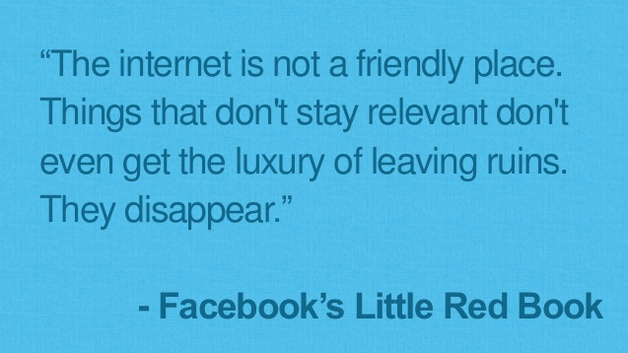
Speed. That was my takeaway. If you’re not fast enough to innovate and disrupt your own business, someone else will.
#2 – Brand Strategy
Your brand is everywhere. It’s on your website, in your emails, it’s even in the tone of your voice when you’re speaking to customers over the phone. Dana DiTomaso reminds us to control the experience. Humans like consistency. It breeds trust.

Define the Brand
If you’re having a brand identity crisis, Dana suggests implementing a card strategy to give each person on the team a chance to define how they see the brand. We’ve all had a loudmouth in our meetings, this isn’t the time to let them sway the results—each person should be heard.
Who are you? Write about 40 descriptive words on note cards. Hand them over to an individual and ask them to select two cards describing what the brand “is” and two cards describing what the brand “isn’t”. After each person on the team has completed the exercise, you’ll have a good idea if there is a disconnect. Does your messaging need to be strengthened internally? If your team is confused, your customers are going to be mega confused.
Voice and tone. We’ve mentioned voice and tone before, but the importance was confirmed in Dana’s talk. Once you define it, you have to get every department on board. You don’t want customer support sounding like a bunch of robots while marketing is sounding like a cheer squad.
Execute
Part of being memorable is knowing who you don’t serve. Trying to serve everyone on the internet is going to dilute your brand. Know your brand. Know your audience.
#3 – Content Success
“If your content is for everybody, then it’s for nobody”. Kristina Halvorson reminded us to determine exactly who we’re trying to reach with our content. Without this, there is no strategy.
Strategy
Like every other startup on the planet, each person on the Rafflecopter team “wears many hats”. With this comes flexibility, learning opportunities, and sometimes a plate overflowing with projects. Content strategy was a huge takeaway for me at MozCon. All of our goals felt so attainable after hearing the speakers’ tips!

Image from Kristina’s slideshare
Divide and conquer. Kristina broke down the components of a content strategy. If you’ve read anything about strategy, the above graphic will be a familiar concept, however it reminded me that it has to be a team effort to succeed. Knowing which section of the strategy you own is important for the overall success.
- Substance: fulfills brand objective by meeting audience needs
- Structure: makes content findable and usable
- Workflow: creates efficiencies across content properties
- Governance: empowers, facilitates, and aligns
Time. In the world of “do more faster”, I was surprised to hear from Matthew Brown (Moz) that you shouldn’t expect to see huge results from a content campaign for at least 12 months. “The #1 thing killing content marketing programs is setting a timeline that’s too short.” A startup can be created and extinguished in 12 months!
Measurement
In the past, content marketing always seemed “fluffy”. Writing a piece just so you could stuff it with keywords for SEO purposes. However, within the last few years content has taken a quick bend towards analytics and data-driven strategy. It all comes back to data.
Audit. Determine what you’re working with. It’s easy to get in the mode of creating content for the sake of creating content, but if you don’t know where you currently stand, you could be going nowhere fast.
Kristina Halvorson stressed the importance of a content audit with a ROT (redundant, outdated, trivial) analysis. A content inventory will help you determine if you need to update old material or delete it altogether.
Blaze was recommended as an inventory tool as well as CAT.
Page metrics. While it’s important to measure time on page, bounce rate, and pageviews, Adrian Vender also pushed us to look at scrolling behaviors, outbound links, and who is downloading the content. This will help give you a full picture of your content’s success. Is it even working?
Google Tag Manager is his tool of choice for measuring these behaviors since it requires little to no dev time and allows for data manipulation similar to Google Analytics.
At the end of the day, it’s about leads and conversions. Readers could spend an hour on your page, but if they don’t convert, something’s missing.
#4 – Facebook
Build a strong search presence
“Get over the page like”. We’re still hung up on getting people to like our pages. We think if we can increase the number of likes on our page, more money will flow into our pockets. Well, that’s not the case, and David Mihm argues for a shift to content sharing for better visibility. After all, less than 2% of your followers are currently seeing your content and people who aren’t following you definitely aren’t seeing it.
It’s time to shift your Facebook efforts. Yes, it requires more work, but it will pay off. Maybe “will” should be changed to “should”—it all depends on the quality of your content. The content you create should inspire sharing. People share for several reasons: it makes them look smart/cool, they want to be helpful, and it helps their friends learn more about them. Play into that.
So, what’s with all the sharing? Facebook is now creeping up as a popular search engine right behind Big Brother Google. More than ever before people are turning to Facebook to find answers, reviews, etc. If your content is not being shared, your results will get buried in the search results. You have to step up your game.
Helpful search queries
We all know targeted marketing is effective. It’s the way to stretch your budget, lock in conversions, and effectively creep out your customers.
In David’s talk, he reminded us of Facebook’s search abilities. If you need to gain a bit more insight into your customers or need some ideas, try these queries with a modifier+subject+verb+object search:
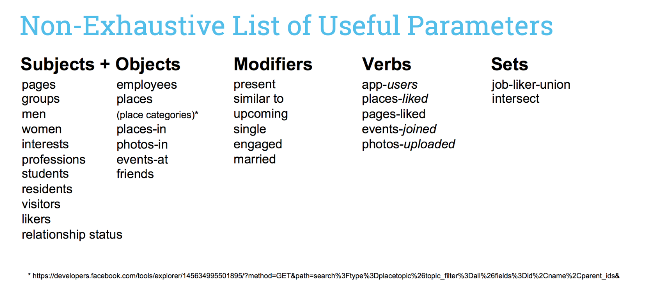
- Need content ideas: “interests liked by people who like (your company)”
- Need an ad audience: “pages liked by people who like (product)”
- Need a review: “people who use yelp and like (your business)”
- Need an influencer: “Marketing Managers who like (topic) and live in (location)”
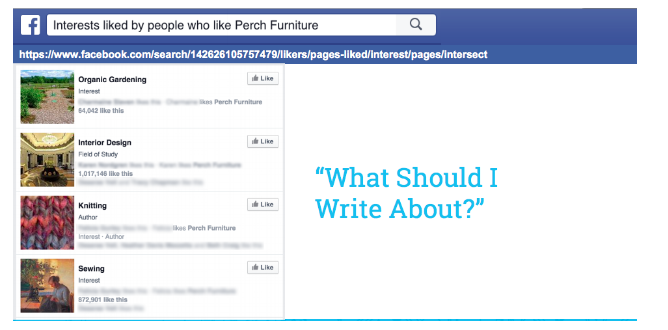
Check out this search tool from Intelligence Software if you need some help with queries.
#5 – How to Cook a Hot Dog
Now on to the most enlightening talk of them all—the culinary expertise of Rafflecopter’s Josh Couper.
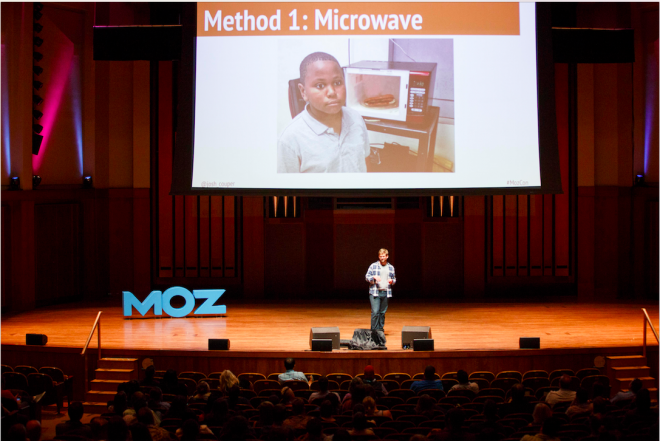
Have you ever heard of cooking a hot dog in a Pringles can? Yeah, I hadn’t either until Josh dropped the knowledge bomb at MozCon’s Ignite event. I’m partial to the “charred” method myself, but an equally appealing tactic is the spiral sliced hot dog.
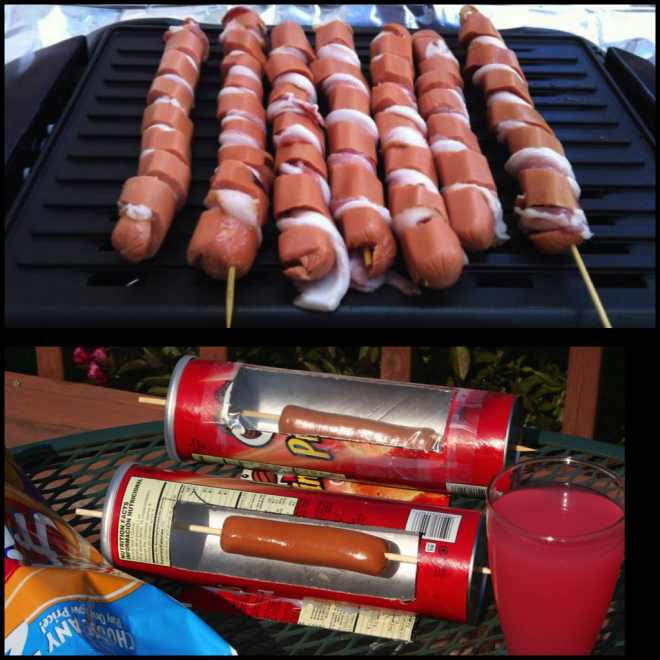
Josh pitched this topic thinking it would never get accepted. Well, Moz called him on his bluff and Josh was like:

It could have been a painfully bizarre talk, but it wasn’t. It was awesome.
Lesson learned: put yourself out there. Even if it means talking about mystery meat to hundreds of marketing professionals.
MozCon Conclusion
Only attend conferences hosted by hipsters. That’s my new rule.